To Compare Motivational Factors: Hilton Hotel Case Study Report
VerifiedAdded on 2020/01/15
|15
|2650
|193
Report
AI Summary
This research project investigates the effectiveness of non-financial motivational factors compared to financial factors within the hospitality industry, using Hilton Hotel as a case study. The report begins with an outline of the research, including aims, objectives, research questions, and methodology. It explores various factors influencing research project selection, such as the researcher's interest, the scope of the study, and contemporary issues. The study employs both primary and secondary data collection methods, including questionnaires administered to 50 middle-level Hilton Hotel employees. The research evaluates themes related to the types of non-financial motivational means used by Hilton, the reward policies that motivate employees, and whether non-financial rewards make employees feel valued. The findings suggest that non-financial factors are more effective in maintaining long-term employee motivation, particularly for middle-level employees. The report concludes with recommendations for Hilton Hotel management, suggesting a tailored approach to rewards based on employee level, and proposes further areas of research to explore the appropriateness of financial motivational factors.

RESEARCH PROJECT
Paraphrase This Document
Need a fresh take? Get an instant paraphrase of this document with our AI Paraphraser
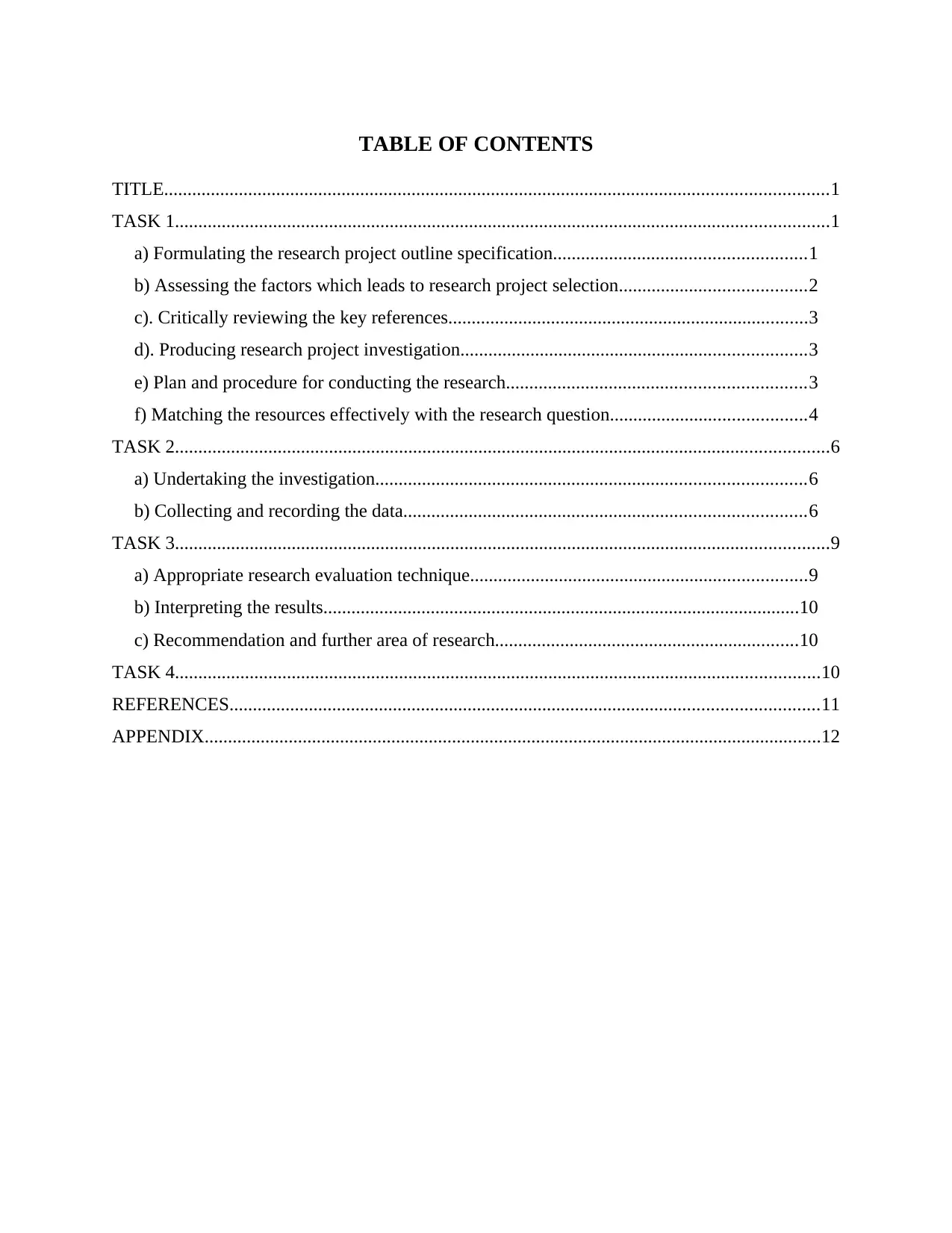
TABLE OF CONTENTS
TITLE..............................................................................................................................................1
TASK 1............................................................................................................................................1
a) Formulating the research project outline specification......................................................1
b) Assessing the factors which leads to research project selection........................................2
c). Critically reviewing the key references.............................................................................3
d). Producing research project investigation..........................................................................3
e) Plan and procedure for conducting the research................................................................3
f) Matching the resources effectively with the research question..........................................4
TASK 2............................................................................................................................................6
a) Undertaking the investigation............................................................................................6
b) Collecting and recording the data......................................................................................6
TASK 3............................................................................................................................................9
a) Appropriate research evaluation technique........................................................................9
b) Interpreting the results......................................................................................................10
c) Recommendation and further area of research.................................................................10
TASK 4..........................................................................................................................................10
REFERENCES..............................................................................................................................11
APPENDIX....................................................................................................................................12
TITLE..............................................................................................................................................1
TASK 1............................................................................................................................................1
a) Formulating the research project outline specification......................................................1
b) Assessing the factors which leads to research project selection........................................2
c). Critically reviewing the key references.............................................................................3
d). Producing research project investigation..........................................................................3
e) Plan and procedure for conducting the research................................................................3
f) Matching the resources effectively with the research question..........................................4
TASK 2............................................................................................................................................6
a) Undertaking the investigation............................................................................................6
b) Collecting and recording the data......................................................................................6
TASK 3............................................................................................................................................9
a) Appropriate research evaluation technique........................................................................9
b) Interpreting the results......................................................................................................10
c) Recommendation and further area of research.................................................................10
TASK 4..........................................................................................................................................10
REFERENCES..............................................................................................................................11
APPENDIX....................................................................................................................................12

ILLUSTRATION INDEX
Illustration 1: Theme 1.....................................................................................................................7
Illustration 2: Theme 2.....................................................................................................................8
Illustration 3: Theme 3.....................................................................................................................8
Illustration 1: Theme 1.....................................................................................................................7
Illustration 2: Theme 2.....................................................................................................................8
Illustration 3: Theme 3.....................................................................................................................8
⊘ This is a preview!⊘
Do you want full access?
Subscribe today to unlock all pages.

Trusted by 1+ million students worldwide
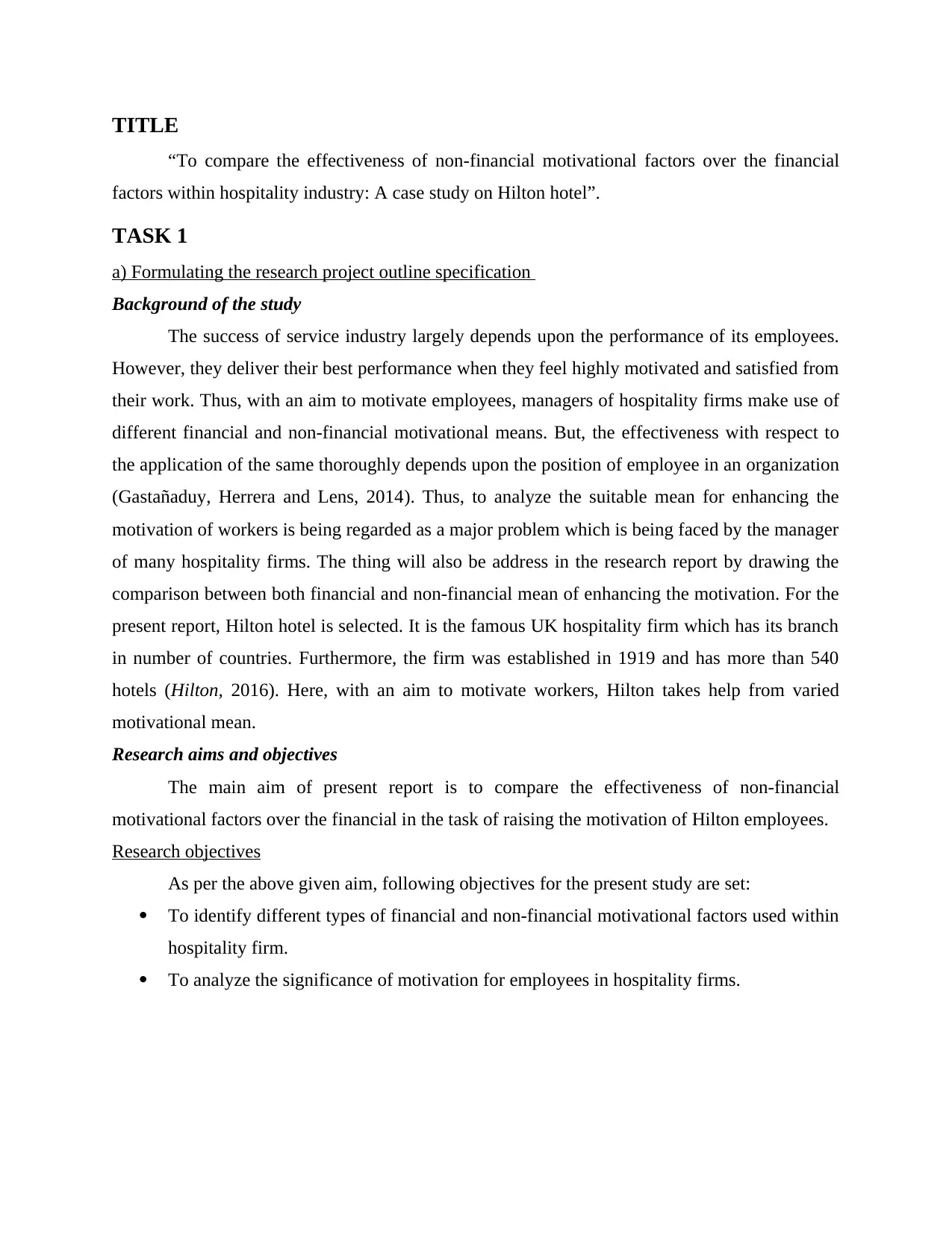
TITLE
“To compare the effectiveness of non-financial motivational factors over the financial
factors within hospitality industry: A case study on Hilton hotel”.
TASK 1
a) Formulating the research project outline specification
Background of the study
The success of service industry largely depends upon the performance of its employees.
However, they deliver their best performance when they feel highly motivated and satisfied from
their work. Thus, with an aim to motivate employees, managers of hospitality firms make use of
different financial and non-financial motivational means. But, the effectiveness with respect to
the application of the same thoroughly depends upon the position of employee in an organization
(Gastañaduy, Herrera and Lens, 2014 ). Thus, to analyze the suitable mean for enhancing the
motivation of workers is being regarded as a major problem which is being faced by the manager
of many hospitality firms. The thing will also be address in the research report by drawing the
comparison between both financial and non-financial mean of enhancing the motivation. For the
present report, Hilton hotel is selected. It is the famous UK hospitality firm which has its branch
in number of countries. Furthermore, the firm was established in 1919 and has more than 540
hotels (Hilton, 2016). Here, with an aim to motivate workers, Hilton takes help from varied
motivational mean.
Research aims and objectives
The main aim of present report is to compare the effectiveness of non-financial
motivational factors over the financial in the task of raising the motivation of Hilton employees.
Research objectives
As per the above given aim, following objectives for the present study are set:
To identify different types of financial and non-financial motivational factors used within
hospitality firm.
To analyze the significance of motivation for employees in hospitality firms.
“To compare the effectiveness of non-financial motivational factors over the financial
factors within hospitality industry: A case study on Hilton hotel”.
TASK 1
a) Formulating the research project outline specification
Background of the study
The success of service industry largely depends upon the performance of its employees.
However, they deliver their best performance when they feel highly motivated and satisfied from
their work. Thus, with an aim to motivate employees, managers of hospitality firms make use of
different financial and non-financial motivational means. But, the effectiveness with respect to
the application of the same thoroughly depends upon the position of employee in an organization
(Gastañaduy, Herrera and Lens, 2014 ). Thus, to analyze the suitable mean for enhancing the
motivation of workers is being regarded as a major problem which is being faced by the manager
of many hospitality firms. The thing will also be address in the research report by drawing the
comparison between both financial and non-financial mean of enhancing the motivation. For the
present report, Hilton hotel is selected. It is the famous UK hospitality firm which has its branch
in number of countries. Furthermore, the firm was established in 1919 and has more than 540
hotels (Hilton, 2016). Here, with an aim to motivate workers, Hilton takes help from varied
motivational mean.
Research aims and objectives
The main aim of present report is to compare the effectiveness of non-financial
motivational factors over the financial in the task of raising the motivation of Hilton employees.
Research objectives
As per the above given aim, following objectives for the present study are set:
To identify different types of financial and non-financial motivational factors used within
hospitality firm.
To analyze the significance of motivation for employees in hospitality firms.
Paraphrase This Document
Need a fresh take? Get an instant paraphrase of this document with our AI Paraphraser
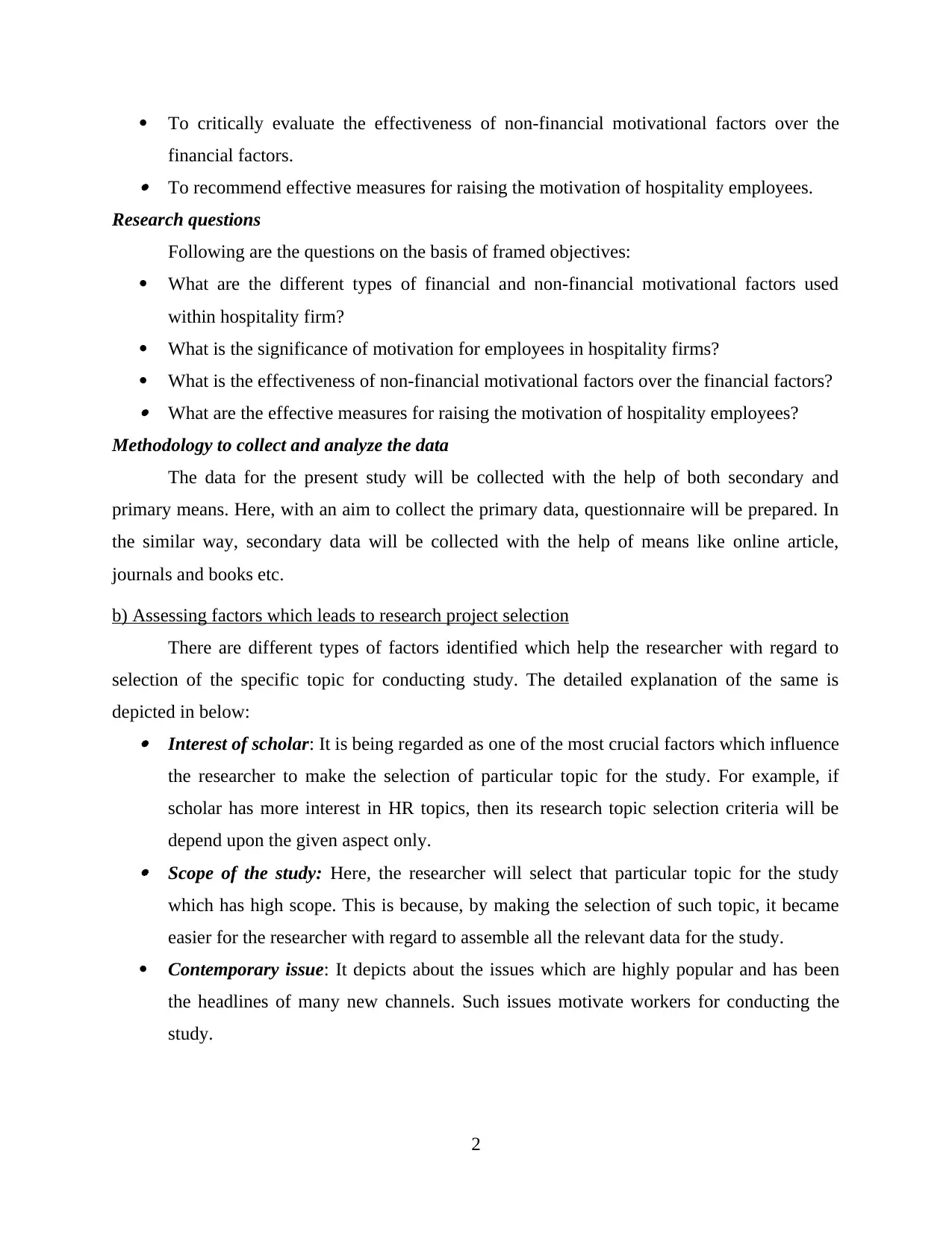
To critically evaluate the effectiveness of non-financial motivational factors over the
financial factors. To recommend effective measures for raising the motivation of hospitality employees.
Research questions
Following are the questions on the basis of framed objectives:
What are the different types of financial and non-financial motivational factors used
within hospitality firm?
What is the significance of motivation for employees in hospitality firms?
What is the effectiveness of non-financial motivational factors over the financial factors? What are the effective measures for raising the motivation of hospitality employees?
Methodology to collect and analyze the data
The data for the present study will be collected with the help of both secondary and
primary means. Here, with an aim to collect the primary data, questionnaire will be prepared. In
the similar way, secondary data will be collected with the help of means like online article,
journals and books etc.
b) Assessing factors which leads to research project selection
There are different types of factors identified which help the researcher with regard to
selection of the specific topic for conducting study. The detailed explanation of the same is
depicted in below: Interest of scholar: It is being regarded as one of the most crucial factors which influence
the researcher to make the selection of particular topic for the study. For example, if
scholar has more interest in HR topics, then its research topic selection criteria will be
depend upon the given aspect only. Scope of the study: Here, the researcher will select that particular topic for the study
which has high scope. This is because, by making the selection of such topic, it became
easier for the researcher with regard to assemble all the relevant data for the study.
Contemporary issue: It depicts about the issues which are highly popular and has been
the headlines of many new channels. Such issues motivate workers for conducting the
study.
2
financial factors. To recommend effective measures for raising the motivation of hospitality employees.
Research questions
Following are the questions on the basis of framed objectives:
What are the different types of financial and non-financial motivational factors used
within hospitality firm?
What is the significance of motivation for employees in hospitality firms?
What is the effectiveness of non-financial motivational factors over the financial factors? What are the effective measures for raising the motivation of hospitality employees?
Methodology to collect and analyze the data
The data for the present study will be collected with the help of both secondary and
primary means. Here, with an aim to collect the primary data, questionnaire will be prepared. In
the similar way, secondary data will be collected with the help of means like online article,
journals and books etc.
b) Assessing factors which leads to research project selection
There are different types of factors identified which help the researcher with regard to
selection of the specific topic for conducting study. The detailed explanation of the same is
depicted in below: Interest of scholar: It is being regarded as one of the most crucial factors which influence
the researcher to make the selection of particular topic for the study. For example, if
scholar has more interest in HR topics, then its research topic selection criteria will be
depend upon the given aspect only. Scope of the study: Here, the researcher will select that particular topic for the study
which has high scope. This is because, by making the selection of such topic, it became
easier for the researcher with regard to assemble all the relevant data for the study.
Contemporary issue: It depicts about the issues which are highly popular and has been
the headlines of many new channels. Such issues motivate workers for conducting the
study.
2
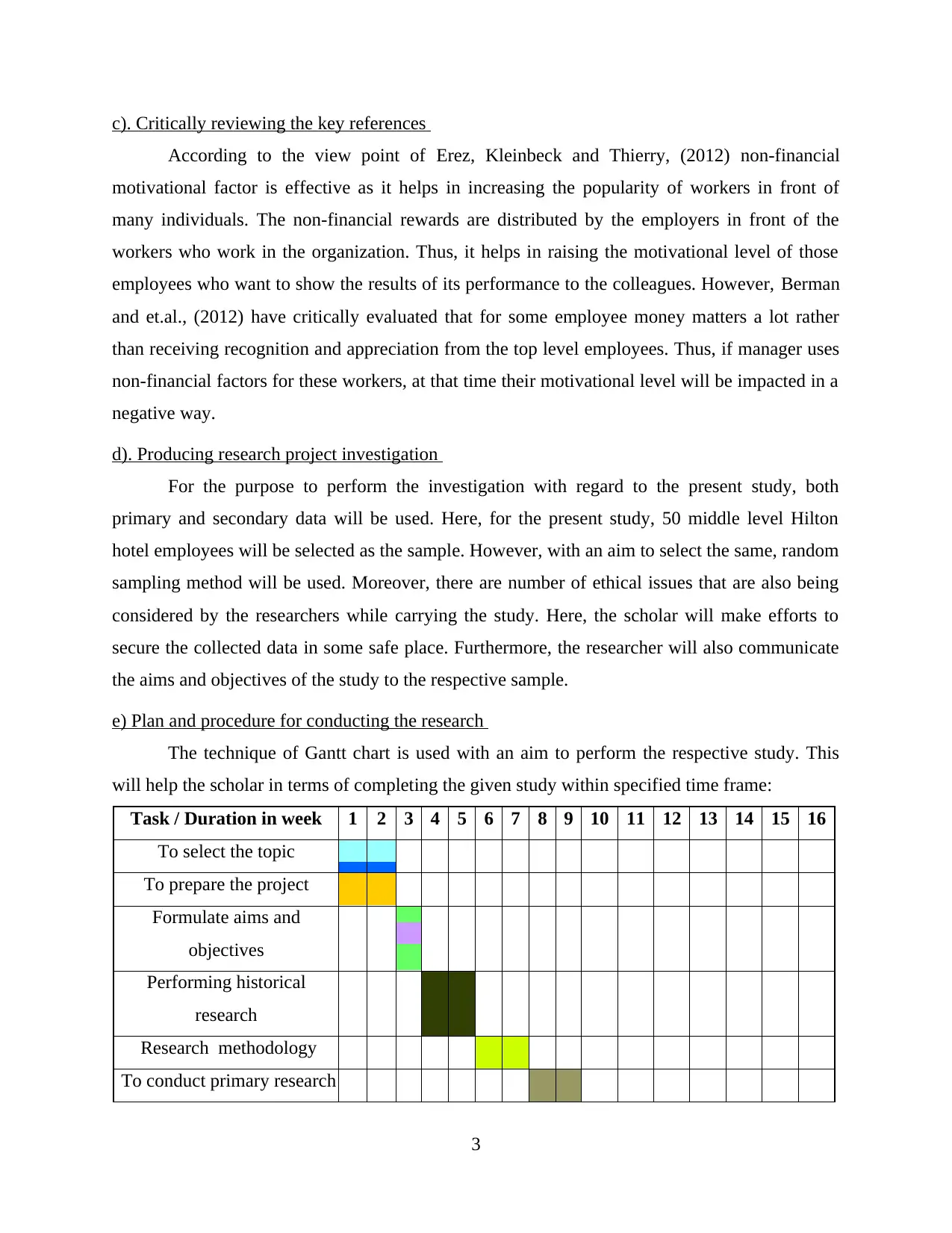
c). Critically reviewing the key references
According to the view point of Erez, Kleinbeck and Thierry, (2012) non-financial
motivational factor is effective as it helps in increasing the popularity of workers in front of
many individuals. The non-financial rewards are distributed by the employers in front of the
workers who work in the organization. Thus, it helps in raising the motivational level of those
employees who want to show the results of its performance to the colleagues. However, Berman
and et.al., (2012) have critically evaluated that for some employee money matters a lot rather
than receiving recognition and appreciation from the top level employees. Thus, if manager uses
non-financial factors for these workers, at that time their motivational level will be impacted in a
negative way.
d). Producing research project investigation
For the purpose to perform the investigation with regard to the present study, both
primary and secondary data will be used. Here, for the present study, 50 middle level Hilton
hotel employees will be selected as the sample. However, with an aim to select the same, random
sampling method will be used. Moreover, there are number of ethical issues that are also being
considered by the researchers while carrying the study. Here, the scholar will make efforts to
secure the collected data in some safe place. Furthermore, the researcher will also communicate
the aims and objectives of the study to the respective sample.
e) Plan and procedure for conducting the research
The technique of Gantt chart is used with an aim to perform the respective study. This
will help the scholar in terms of completing the given study within specified time frame:
Task / Duration in week 1 2 3 4 5 6 7 8 9 10 11 12 13 14 15 16
To select the topic
To prepare the project
Formulate aims and
objectives
Performing historical
research
Research methodology
To conduct primary research
3
According to the view point of Erez, Kleinbeck and Thierry, (2012) non-financial
motivational factor is effective as it helps in increasing the popularity of workers in front of
many individuals. The non-financial rewards are distributed by the employers in front of the
workers who work in the organization. Thus, it helps in raising the motivational level of those
employees who want to show the results of its performance to the colleagues. However, Berman
and et.al., (2012) have critically evaluated that for some employee money matters a lot rather
than receiving recognition and appreciation from the top level employees. Thus, if manager uses
non-financial factors for these workers, at that time their motivational level will be impacted in a
negative way.
d). Producing research project investigation
For the purpose to perform the investigation with regard to the present study, both
primary and secondary data will be used. Here, for the present study, 50 middle level Hilton
hotel employees will be selected as the sample. However, with an aim to select the same, random
sampling method will be used. Moreover, there are number of ethical issues that are also being
considered by the researchers while carrying the study. Here, the scholar will make efforts to
secure the collected data in some safe place. Furthermore, the researcher will also communicate
the aims and objectives of the study to the respective sample.
e) Plan and procedure for conducting the research
The technique of Gantt chart is used with an aim to perform the respective study. This
will help the scholar in terms of completing the given study within specified time frame:
Task / Duration in week 1 2 3 4 5 6 7 8 9 10 11 12 13 14 15 16
To select the topic
To prepare the project
Formulate aims and
objectives
Performing historical
research
Research methodology
To conduct primary research
3
⊘ This is a preview!⊘
Do you want full access?
Subscribe today to unlock all pages.

Trusted by 1+ million students worldwide
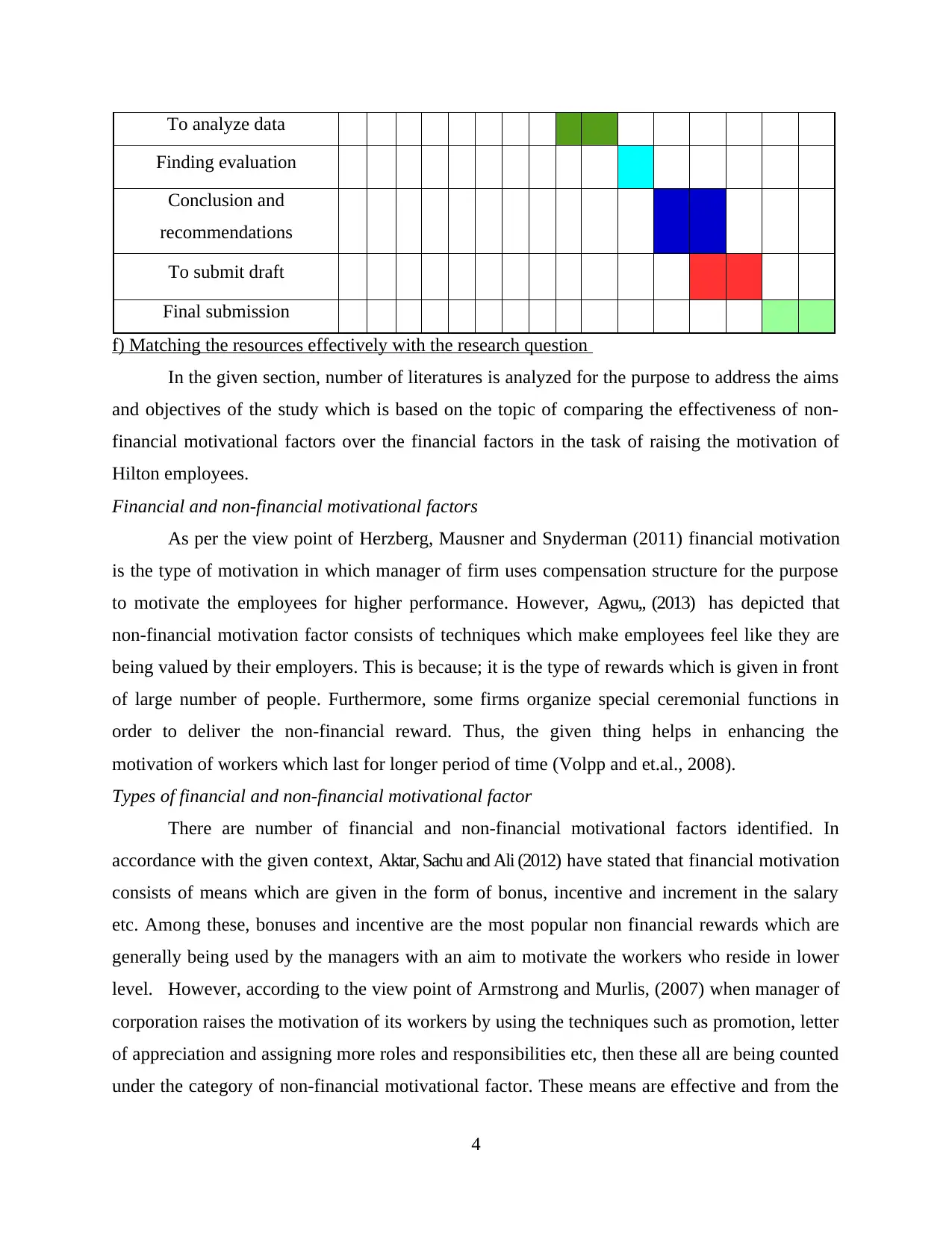
To analyze data
Finding evaluation
Conclusion and
recommendations
To submit draft
Final submission
f) Matching the resources effectively with the research question
In the given section, number of literatures is analyzed for the purpose to address the aims
and objectives of the study which is based on the topic of comparing the effectiveness of non-
financial motivational factors over the financial factors in the task of raising the motivation of
Hilton employees.
Financial and non-financial motivational factors
As per the view point of Herzberg, Mausner and Snyderman (2011) financial motivation
is the type of motivation in which manager of firm uses compensation structure for the purpose
to motivate the employees for higher performance. However, Agwu,, (2013) has depicted that
non-financial motivation factor consists of techniques which make employees feel like they are
being valued by their employers. This is because; it is the type of rewards which is given in front
of large number of people. Furthermore, some firms organize special ceremonial functions in
order to deliver the non-financial reward. Thus, the given thing helps in enhancing the
motivation of workers which last for longer period of time (Volpp and et.al., 2008).
Types of financial and non-financial motivational factor
There are number of financial and non-financial motivational factors identified. In
accordance with the given context, Aktar, Sachu and Ali (2012) have stated that financial motivation
consists of means which are given in the form of bonus, incentive and increment in the salary
etc. Among these, bonuses and incentive are the most popular non financial rewards which are
generally being used by the managers with an aim to motivate the workers who reside in lower
level. However, according to the view point of Armstrong and Murlis, (2007) when manager of
corporation raises the motivation of its workers by using the techniques such as promotion, letter
of appreciation and assigning more roles and responsibilities etc, then these all are being counted
under the category of non-financial motivational factor. These means are effective and from the
4
Finding evaluation
Conclusion and
recommendations
To submit draft
Final submission
f) Matching the resources effectively with the research question
In the given section, number of literatures is analyzed for the purpose to address the aims
and objectives of the study which is based on the topic of comparing the effectiveness of non-
financial motivational factors over the financial factors in the task of raising the motivation of
Hilton employees.
Financial and non-financial motivational factors
As per the view point of Herzberg, Mausner and Snyderman (2011) financial motivation
is the type of motivation in which manager of firm uses compensation structure for the purpose
to motivate the employees for higher performance. However, Agwu,, (2013) has depicted that
non-financial motivation factor consists of techniques which make employees feel like they are
being valued by their employers. This is because; it is the type of rewards which is given in front
of large number of people. Furthermore, some firms organize special ceremonial functions in
order to deliver the non-financial reward. Thus, the given thing helps in enhancing the
motivation of workers which last for longer period of time (Volpp and et.al., 2008).
Types of financial and non-financial motivational factor
There are number of financial and non-financial motivational factors identified. In
accordance with the given context, Aktar, Sachu and Ali (2012) have stated that financial motivation
consists of means which are given in the form of bonus, incentive and increment in the salary
etc. Among these, bonuses and incentive are the most popular non financial rewards which are
generally being used by the managers with an aim to motivate the workers who reside in lower
level. However, according to the view point of Armstrong and Murlis, (2007) when manager of
corporation raises the motivation of its workers by using the techniques such as promotion, letter
of appreciation and assigning more roles and responsibilities etc, then these all are being counted
under the category of non-financial motivational factor. These means are effective and from the
4
Paraphrase This Document
Need a fresh take? Get an instant paraphrase of this document with our AI Paraphraser
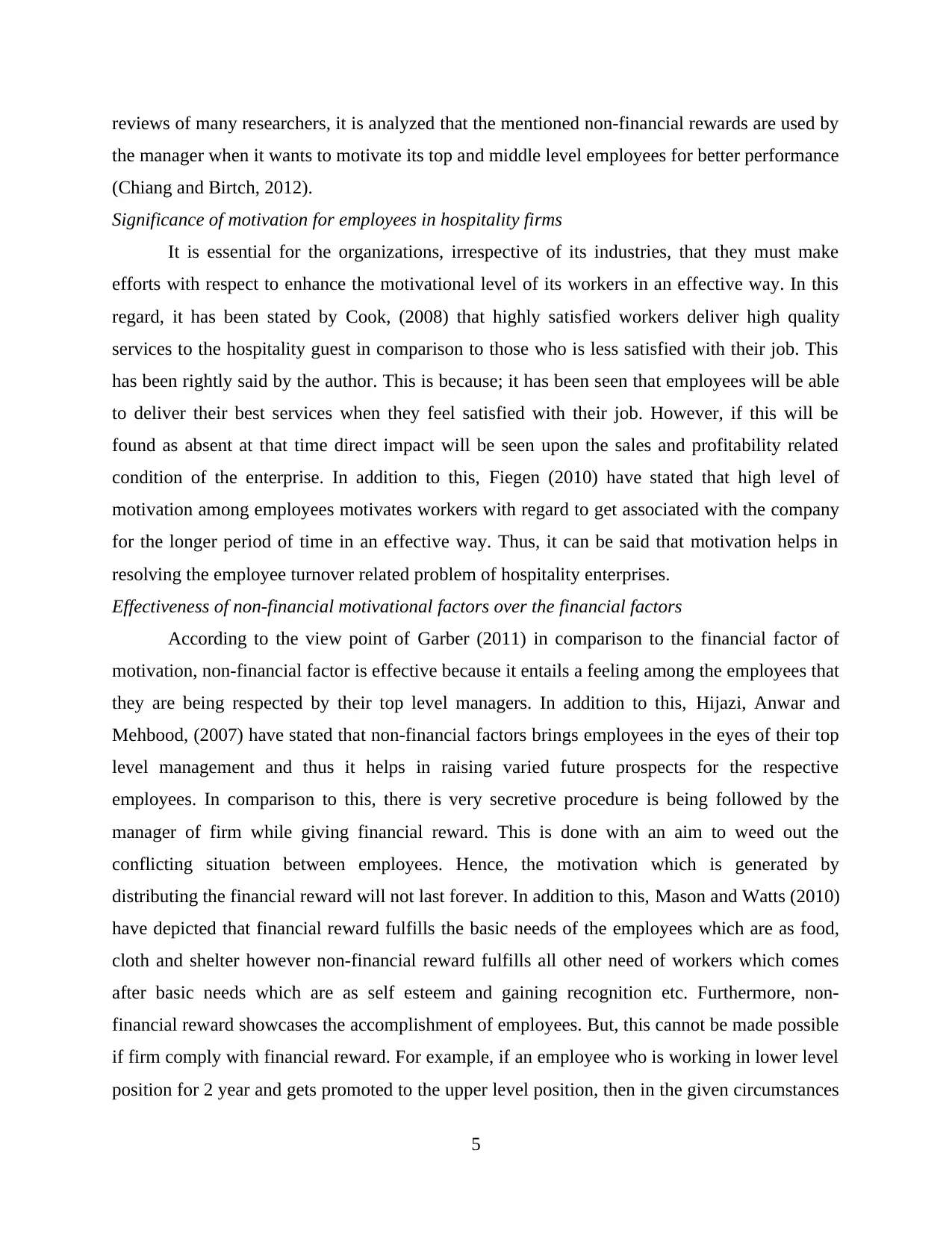
reviews of many researchers, it is analyzed that the mentioned non-financial rewards are used by
the manager when it wants to motivate its top and middle level employees for better performance
(Chiang and Birtch, 2012).
Significance of motivation for employees in hospitality firms
It is essential for the organizations, irrespective of its industries, that they must make
efforts with respect to enhance the motivational level of its workers in an effective way. In this
regard, it has been stated by Cook, (2008) that highly satisfied workers deliver high quality
services to the hospitality guest in comparison to those who is less satisfied with their job. This
has been rightly said by the author. This is because; it has been seen that employees will be able
to deliver their best services when they feel satisfied with their job. However, if this will be
found as absent at that time direct impact will be seen upon the sales and profitability related
condition of the enterprise. In addition to this, Fiegen (2010) have stated that high level of
motivation among employees motivates workers with regard to get associated with the company
for the longer period of time in an effective way. Thus, it can be said that motivation helps in
resolving the employee turnover related problem of hospitality enterprises.
Effectiveness of non-financial motivational factors over the financial factors
According to the view point of Garber (2011) in comparison to the financial factor of
motivation, non-financial factor is effective because it entails a feeling among the employees that
they are being respected by their top level managers. In addition to this, Hijazi, Anwar and
Mehbood, (2007) have stated that non-financial factors brings employees in the eyes of their top
level management and thus it helps in raising varied future prospects for the respective
employees. In comparison to this, there is very secretive procedure is being followed by the
manager of firm while giving financial reward. This is done with an aim to weed out the
conflicting situation between employees. Hence, the motivation which is generated by
distributing the financial reward will not last forever. In addition to this, Mason and Watts (2010)
have depicted that financial reward fulfills the basic needs of the employees which are as food,
cloth and shelter however non-financial reward fulfills all other need of workers which comes
after basic needs which are as self esteem and gaining recognition etc. Furthermore, non-
financial reward showcases the accomplishment of employees. But, this cannot be made possible
if firm comply with financial reward. For example, if an employee who is working in lower level
position for 2 year and gets promoted to the upper level position, then in the given circumstances
5
the manager when it wants to motivate its top and middle level employees for better performance
(Chiang and Birtch, 2012).
Significance of motivation for employees in hospitality firms
It is essential for the organizations, irrespective of its industries, that they must make
efforts with respect to enhance the motivational level of its workers in an effective way. In this
regard, it has been stated by Cook, (2008) that highly satisfied workers deliver high quality
services to the hospitality guest in comparison to those who is less satisfied with their job. This
has been rightly said by the author. This is because; it has been seen that employees will be able
to deliver their best services when they feel satisfied with their job. However, if this will be
found as absent at that time direct impact will be seen upon the sales and profitability related
condition of the enterprise. In addition to this, Fiegen (2010) have stated that high level of
motivation among employees motivates workers with regard to get associated with the company
for the longer period of time in an effective way. Thus, it can be said that motivation helps in
resolving the employee turnover related problem of hospitality enterprises.
Effectiveness of non-financial motivational factors over the financial factors
According to the view point of Garber (2011) in comparison to the financial factor of
motivation, non-financial factor is effective because it entails a feeling among the employees that
they are being respected by their top level managers. In addition to this, Hijazi, Anwar and
Mehbood, (2007) have stated that non-financial factors brings employees in the eyes of their top
level management and thus it helps in raising varied future prospects for the respective
employees. In comparison to this, there is very secretive procedure is being followed by the
manager of firm while giving financial reward. This is done with an aim to weed out the
conflicting situation between employees. Hence, the motivation which is generated by
distributing the financial reward will not last forever. In addition to this, Mason and Watts (2010)
have depicted that financial reward fulfills the basic needs of the employees which are as food,
cloth and shelter however non-financial reward fulfills all other need of workers which comes
after basic needs which are as self esteem and gaining recognition etc. Furthermore, non-
financial reward showcases the accomplishment of employees. But, this cannot be made possible
if firm comply with financial reward. For example, if an employee who is working in lower level
position for 2 year and gets promoted to the upper level position, then in the given circumstances
5
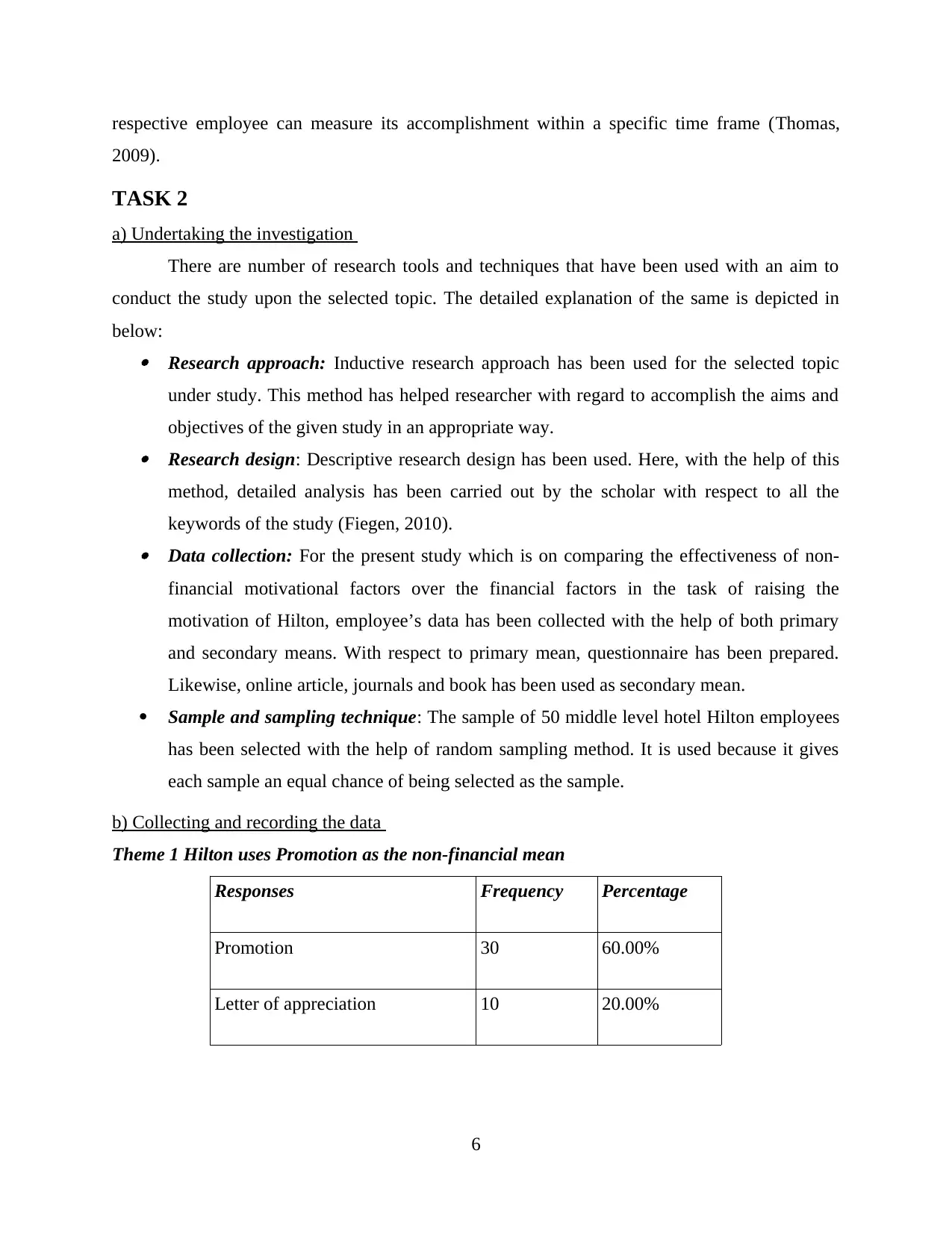
respective employee can measure its accomplishment within a specific time frame (Thomas,
2009).
TASK 2
a) Undertaking the investigation
There are number of research tools and techniques that have been used with an aim to
conduct the study upon the selected topic. The detailed explanation of the same is depicted in
below: Research approach: Inductive research approach has been used for the selected topic
under study. This method has helped researcher with regard to accomplish the aims and
objectives of the given study in an appropriate way. Research design: Descriptive research design has been used. Here, with the help of this
method, detailed analysis has been carried out by the scholar with respect to all the
keywords of the study (Fiegen, 2010). Data collection: For the present study which is on comparing the effectiveness of non-
financial motivational factors over the financial factors in the task of raising the
motivation of Hilton, employee’s data has been collected with the help of both primary
and secondary means. With respect to primary mean, questionnaire has been prepared.
Likewise, online article, journals and book has been used as secondary mean.
Sample and sampling technique: The sample of 50 middle level hotel Hilton employees
has been selected with the help of random sampling method. It is used because it gives
each sample an equal chance of being selected as the sample.
b) Collecting and recording the data
Theme 1 Hilton uses Promotion as the non-financial mean
Responses Frequency Percentage
Promotion 30 60.00%
Letter of appreciation 10 20.00%
6
2009).
TASK 2
a) Undertaking the investigation
There are number of research tools and techniques that have been used with an aim to
conduct the study upon the selected topic. The detailed explanation of the same is depicted in
below: Research approach: Inductive research approach has been used for the selected topic
under study. This method has helped researcher with regard to accomplish the aims and
objectives of the given study in an appropriate way. Research design: Descriptive research design has been used. Here, with the help of this
method, detailed analysis has been carried out by the scholar with respect to all the
keywords of the study (Fiegen, 2010). Data collection: For the present study which is on comparing the effectiveness of non-
financial motivational factors over the financial factors in the task of raising the
motivation of Hilton, employee’s data has been collected with the help of both primary
and secondary means. With respect to primary mean, questionnaire has been prepared.
Likewise, online article, journals and book has been used as secondary mean.
Sample and sampling technique: The sample of 50 middle level hotel Hilton employees
has been selected with the help of random sampling method. It is used because it gives
each sample an equal chance of being selected as the sample.
b) Collecting and recording the data
Theme 1 Hilton uses Promotion as the non-financial mean
Responses Frequency Percentage
Promotion 30 60.00%
Letter of appreciation 10 20.00%
6
⊘ This is a preview!⊘
Do you want full access?
Subscribe today to unlock all pages.

Trusted by 1+ million students worldwide
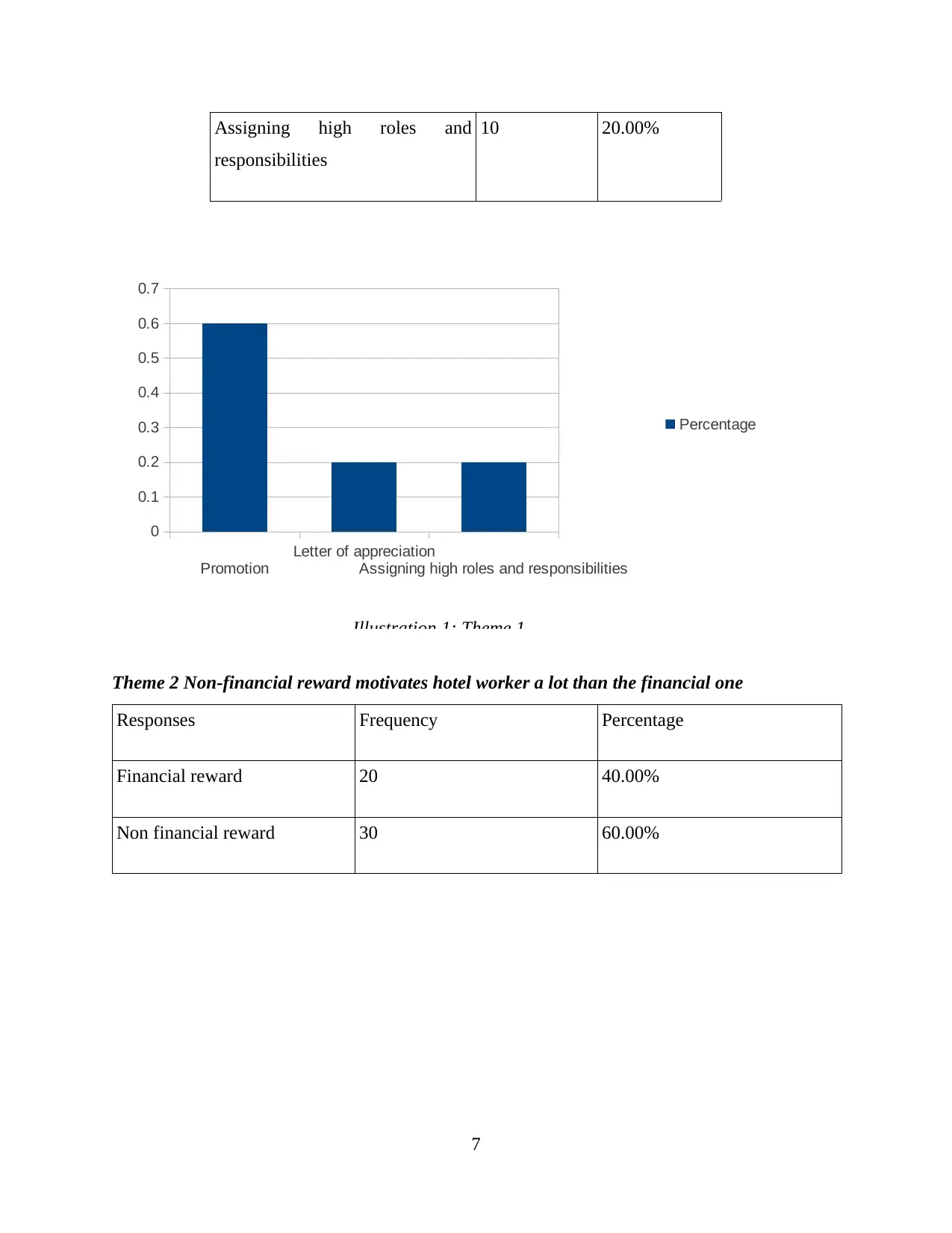
Assigning high roles and
responsibilities
10 20.00%
Theme 2 Non-financial reward motivates hotel worker a lot than the financial one
Responses Frequency Percentage
Financial reward 20 40.00%
Non financial reward 30 60.00%
7
Promotion
Letter of appreciation
Assigning high roles and responsibilities
0
0.1
0.2
0.3
0.4
0.5
0.6
0.7
Percentage
Illustration 1: Theme 1
responsibilities
10 20.00%
Theme 2 Non-financial reward motivates hotel worker a lot than the financial one
Responses Frequency Percentage
Financial reward 20 40.00%
Non financial reward 30 60.00%
7
Promotion
Letter of appreciation
Assigning high roles and responsibilities
0
0.1
0.2
0.3
0.4
0.5
0.6
0.7
Percentage
Illustration 1: Theme 1
Paraphrase This Document
Need a fresh take? Get an instant paraphrase of this document with our AI Paraphraser
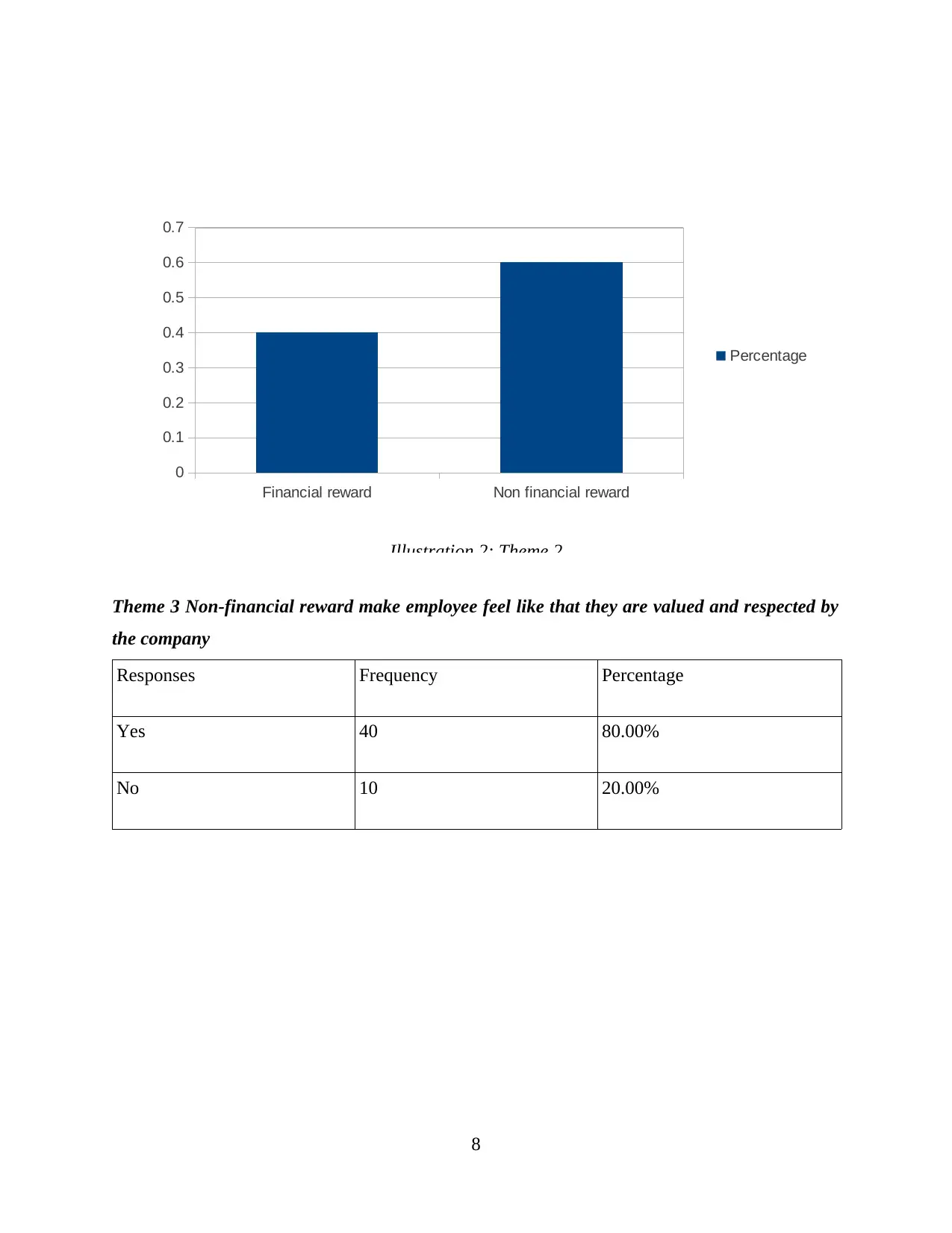
Theme 3 Non-financial reward make employee feel like that they are valued and respected by
the company
Responses Frequency Percentage
Yes 40 80.00%
No 10 20.00%
8
Financial reward Non financial reward
0
0.1
0.2
0.3
0.4
0.5
0.6
0.7
Percentage
Illustration 2: Theme 2
the company
Responses Frequency Percentage
Yes 40 80.00%
No 10 20.00%
8
Financial reward Non financial reward
0
0.1
0.2
0.3
0.4
0.5
0.6
0.7
Percentage
Illustration 2: Theme 2
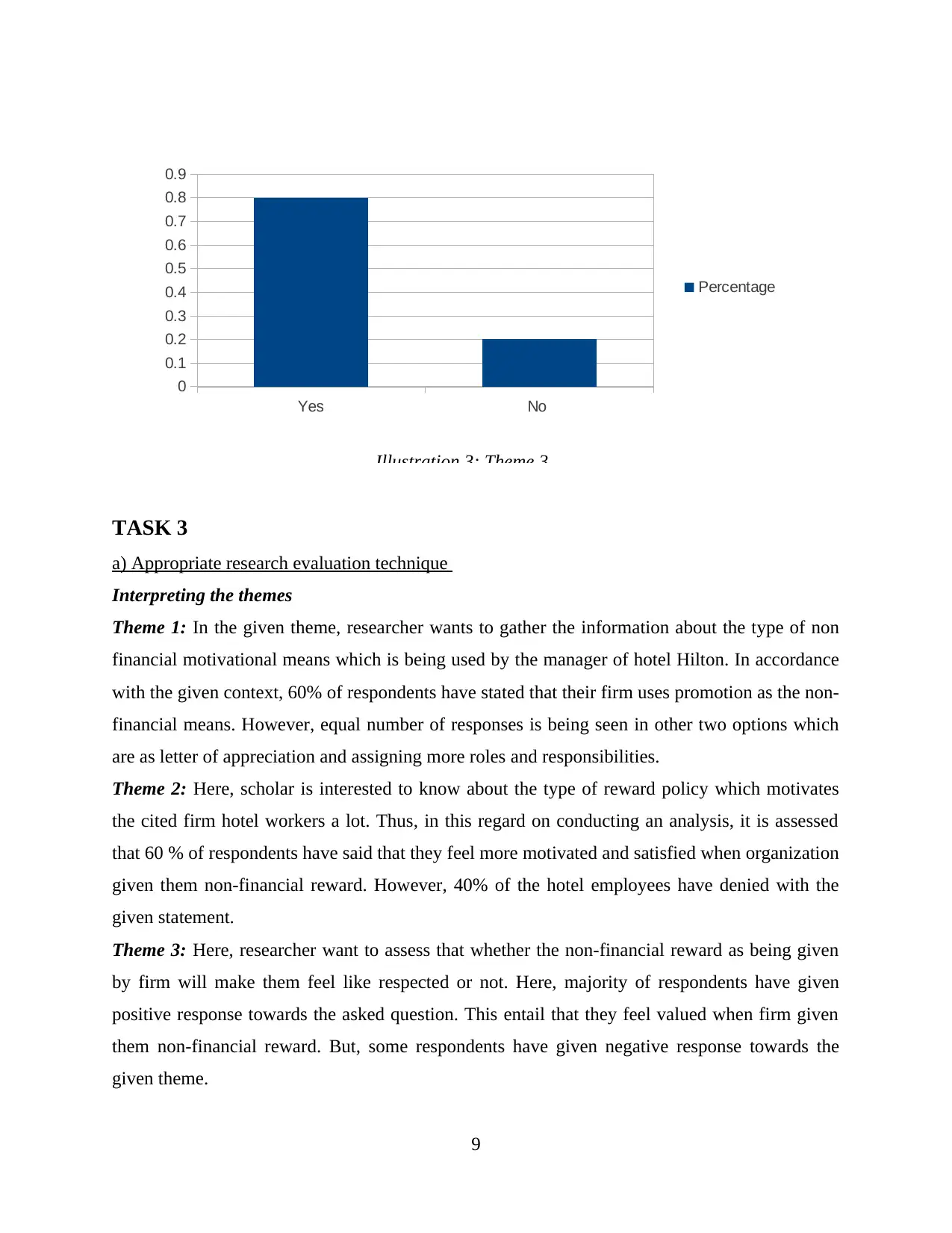
TASK 3
a) Appropriate research evaluation technique
Interpreting the themes
Theme 1: In the given theme, researcher wants to gather the information about the type of non
financial motivational means which is being used by the manager of hotel Hilton. In accordance
with the given context, 60% of respondents have stated that their firm uses promotion as the non-
financial means. However, equal number of responses is being seen in other two options which
are as letter of appreciation and assigning more roles and responsibilities.
Theme 2: Here, scholar is interested to know about the type of reward policy which motivates
the cited firm hotel workers a lot. Thus, in this regard on conducting an analysis, it is assessed
that 60 % of respondents have said that they feel more motivated and satisfied when organization
given them non-financial reward. However, 40% of the hotel employees have denied with the
given statement.
Theme 3: Here, researcher want to assess that whether the non-financial reward as being given
by firm will make them feel like respected or not. Here, majority of respondents have given
positive response towards the asked question. This entail that they feel valued when firm given
them non-financial reward. But, some respondents have given negative response towards the
given theme.
9
Yes No
0
0.1
0.2
0.3
0.4
0.5
0.6
0.7
0.8
0.9
Percentage
Illustration 3: Theme 3
a) Appropriate research evaluation technique
Interpreting the themes
Theme 1: In the given theme, researcher wants to gather the information about the type of non
financial motivational means which is being used by the manager of hotel Hilton. In accordance
with the given context, 60% of respondents have stated that their firm uses promotion as the non-
financial means. However, equal number of responses is being seen in other two options which
are as letter of appreciation and assigning more roles and responsibilities.
Theme 2: Here, scholar is interested to know about the type of reward policy which motivates
the cited firm hotel workers a lot. Thus, in this regard on conducting an analysis, it is assessed
that 60 % of respondents have said that they feel more motivated and satisfied when organization
given them non-financial reward. However, 40% of the hotel employees have denied with the
given statement.
Theme 3: Here, researcher want to assess that whether the non-financial reward as being given
by firm will make them feel like respected or not. Here, majority of respondents have given
positive response towards the asked question. This entail that they feel valued when firm given
them non-financial reward. But, some respondents have given negative response towards the
given theme.
9
Yes No
0
0.1
0.2
0.3
0.4
0.5
0.6
0.7
0.8
0.9
Percentage
Illustration 3: Theme 3
⊘ This is a preview!⊘
Do you want full access?
Subscribe today to unlock all pages.

Trusted by 1+ million students worldwide
1 out of 15
Related Documents
Your All-in-One AI-Powered Toolkit for Academic Success.
+13062052269
info@desklib.com
Available 24*7 on WhatsApp / Email
![[object Object]](/_next/static/media/star-bottom.7253800d.svg)
Unlock your academic potential
Copyright © 2020–2025 A2Z Services. All Rights Reserved. Developed and managed by ZUCOL.





